Leading the Charge: Perspective Of CTOs in Driving Innovation in Established Companies
Posted by Hitul Mistry
/18 Mar 23
Tagged under: #ctos,#innovation,#establishedcompanies
Challenges Faced by CTOs in Driving Innovation in Established Companies :- 1. Legacy Systems and Infrastructure, 2. Silos and Hierarchical Structures
Introduction
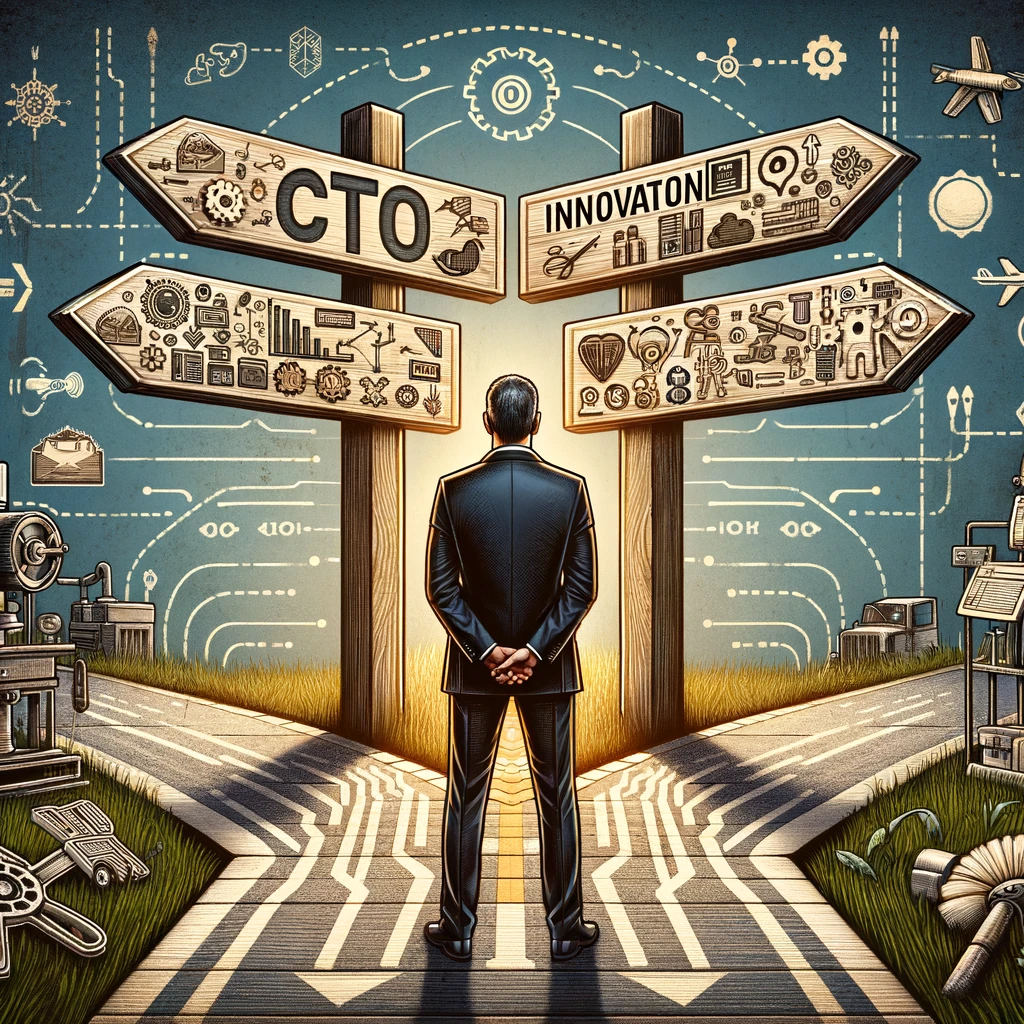
- In today's fast-paced digital world, Chief Technology Officers (CTOs) have tremendous challenges in promoting innovation within established firms. While large organizations have a strong foundation and plenty of resources, they frequently struggle to adapt and innovate owing to various fundamental challenges. In this article, we will discuss the problems and solutions CTOs in driving innovation in established companies.
Challenges Faced by CTOs in Driving Innovation in Established Companies
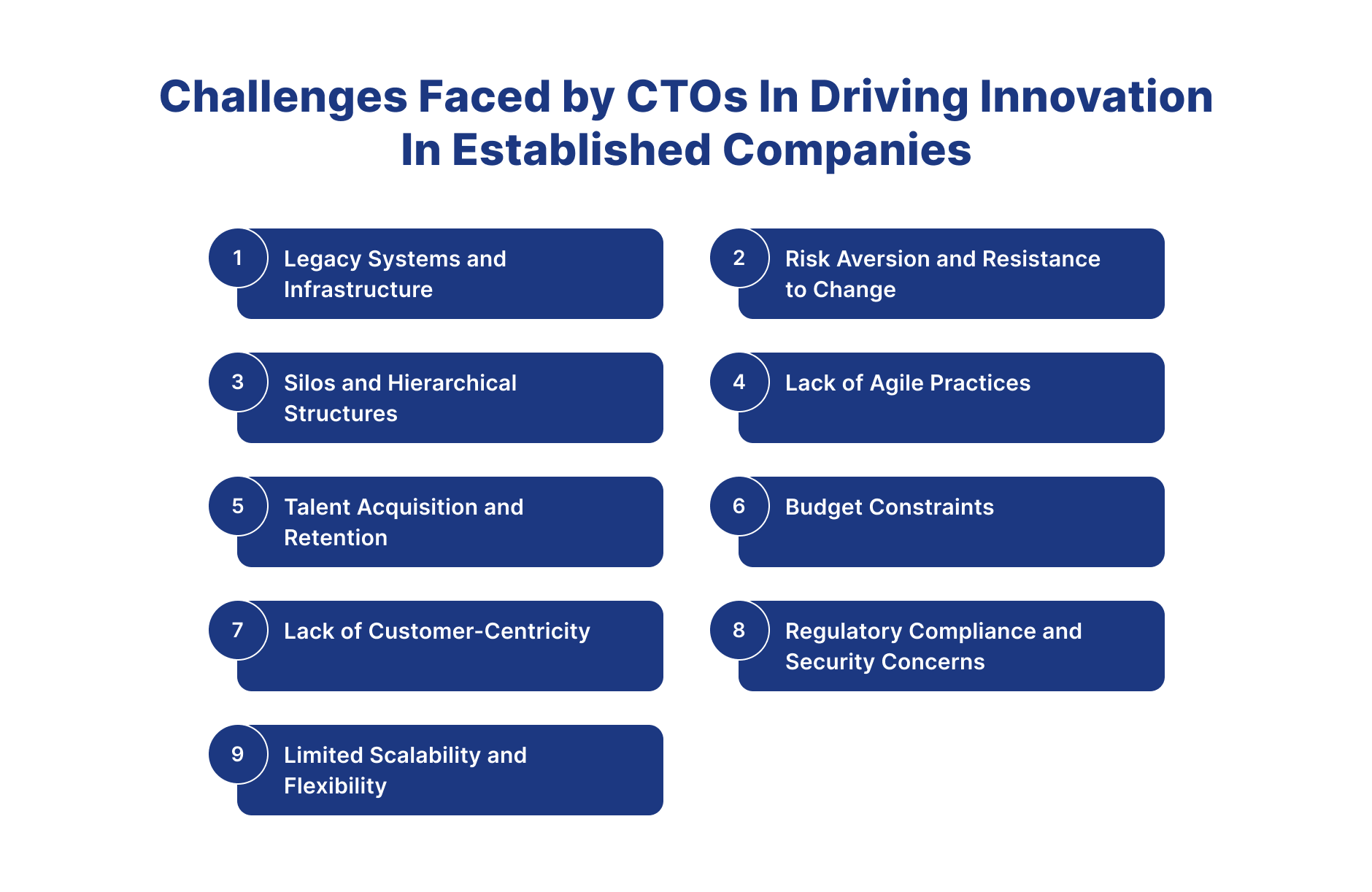
1.Legacy Systems and Infrastructure
- Established businesses usually rely on legacy systems and infrastructure, which might be rigid and difficult to modify. These systems are frequently obsolete and incompatible with contemporary technology, impeding the adoption of creative solutions. If a new legacy system and infrastructure are introduced in the organization, then it is difficult for the CTOs to adopt it. They will need to face many challenges like data migration, budget-related problems, and employees being unable to adopt the change. This can be a challenge faced by CTOs in driving innovation in established companies.
2.Risk Aversion and Resistance to Change
- Many established firms' cultures are deeply engrained with risk aversion. Decision-makers are typically hesitant to adopt new technology and procedures for fear of failure or interruption to established operations. This opposition to change stifles innovation and keeps the organization from capitalizing on new possibilities. If the new legacy systems have been introduced in the organization, then some employees have issues adopting the change. Sometimes, CTOs might fear that if they introduce the change in the organization, there will be a chance of failure to adopt the new technology. This can be a challenge faced by CTOs in driving innovation in established companies.
3.Silos and Hierarchical Structures
- Large corporations are prone to silos and hierarchical systems that stymie cooperation and information sharing between departments. This lack of coherence stifles innovation initiatives since ideas fail to obtain traction and momentum across the organization. This can be a challenge faced by CTOs in driving innovation in established companies.
4.Lack of Agile Practices
- Critical for promoting innovation and quick iteration, Agile approaches are frequently absent or poorly adopted in established businesses. These organizations' inflexible protocols and bureaucratic procedures hold down development cycles and impede innovation. CTOs face this challenge when driving innovation in established companies.
5.Talent Acquisition and Retention
- Attracting top personnel in a competitive market is an ongoing problem for CTOs. Established businesses may struggle to compete with nimble startups and tech titans for competent individuals, resulting in personnel shortages and high turnover rates. If the company adopts a change in the organization, it must acquire and retain a new talent. If the CTOs do not keep the current talent, then they will need to give training to the new employees, which is a waste of time and resources for the organization. This can be a challenge faced by CTOs in driving innovation in established companies.
6.Budget Constraints
- Established organizations sometimes have limited funding for innovation efforts, making it difficult for CTOs to invest in emerging technology and talent acquisition. This limitation can stifle exploration and restrict the scope of innovative endeavors. CTOs must always face budget-related issues in all tasks and work with a limited budget. Adopting change in an established organization with a limited budget is challenging. This can be a challenge which is face by CTOs in driving innovation in established companies.
7.Lack of Customer-Centricity
- Many established organizations base their decision-making processes on internal factors rather than client demands and preferences. This inward concentration may lead to goods and services that fail to connect with the intended audience, inhibiting innovation and growth. Adopting customer-centricity might be challenging when CTOs drive innovation in an established company. If the company is driving innovation, then it needs to train the employees to understand the perception of the customer situation, etc. Because of this training, the company must invest time and money in the employees. This can be a challenge faced by CTOs in driving innovation in established companies.
8.Regulatory Compliance and Security Concerns
-
Established businesses, particularly those in highly regulated areas such as banking and healthcare, must comply with severe regulatory standards and address security risks. Navigating these restrictions while developing may be difficult and time-consuming, frequently impeding the rate of invention.
-
For Example, when CTOs adopt a change in the organization, they must need to consider the WARN Act, which is related to employees. Under the WARN Act, covered employers must notify affected employees, employee representatives (such as unions), state-dislocated worker units, and local government officials of impending layoffs or plant closures. Failure to comply with the WARN Act's notification requirements might result in fines and legal liability for employers. This can be a challenge faced by CTOs in driving innovation in established companies.
9.Limited Scalability and Flexibility
- Alignment among diverse stakeholders, including corporate executives, end users, and project teams, is critical to project success. However, competing agendas, varying expectations, and a lack of stakeholder participation can stymie development and jeopardise project success.
10.Change Management
-
Legacy systems and procedures may lack scalability and flexibility, making it difficult for businesses to respond to changing market needs and grow operations effectively. This rigidity can stymie innovation initiatives as businesses struggle to shift and pursue new possibilities. CTOs must adopt the change in the established organization. If their competitors adopt the change and the CTOs do not, the organization must face circumstances.
-
Nokia is the most recent example of a company that has failed to embrace the changes demanded by the current market. While Nokia's competitors are diligently developing smart Android phones and have already launched their initial offerings, Nokia remains resistant to change. Instead of adapting, Nokia persists in producing traditional phones. However, this reluctance to evolve may lead to their disappearance from the market, as they need help keeping pace with the rapidly evolving smartphone industry. This can be a challenge faced by CTOs in driving innovation in established companies.
Solutions For CTOs In Driving Innovation In Established Companies
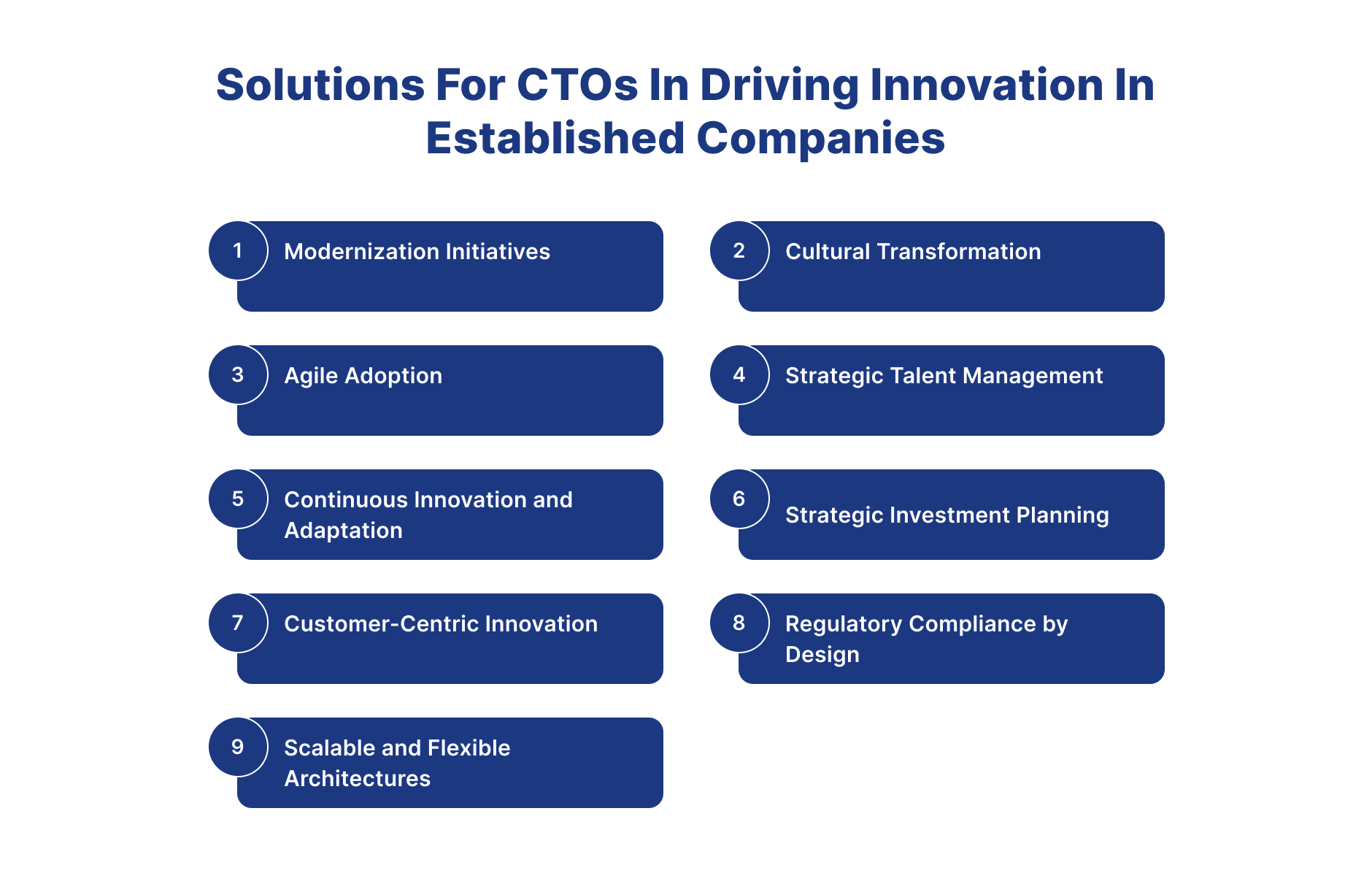
1.Modernization Initiatives
-
These include modernizing outmoded systems, procedures, and technology to meet current industry standards and practices. CTOs may face pushback from personnel who are used to old systems and difficulties integrating new technology into current infrastructure. Solutions include thoroughly evaluating old systems, phased implementation tactics, and employee training programmes to guarantee a seamless transfer. This can be a solution for the CTOs in driving innovation in established companies. Strategic planning can be effective in modernization initiatives.
-
Tech debts convert into legacy systems over time. Each sprint can spend 10% of its time-solving technology debt. Such initiatives can keep a system up and save it from future big investments.
-
CTOs should also monitor the customer experience while upgrading the system. Such initiatives can sometimes cause unexpected errors and issues.
2.Cultural Transformation
-
The culture of the organization represents the end product of the company.
-
Cultural transformation seeks to modify an organization's thinking and behaviors toward change, innovation, and cooperation. CTOs may face pushback from the organization's culture and a lack of employee buy-in. Solutions entail clear communication of vision and objectives, leadership alignment, developing a culture of transparency and innovation, and rewarding preferred behaviors. This can be a solution for the CTOs in driving innovation in established companies.
-
CTOs can measure using the following factors in the organization. If the factors do not apply, then CTOs can stop the cultural change in the organization and build new strategies to adopt these changes.
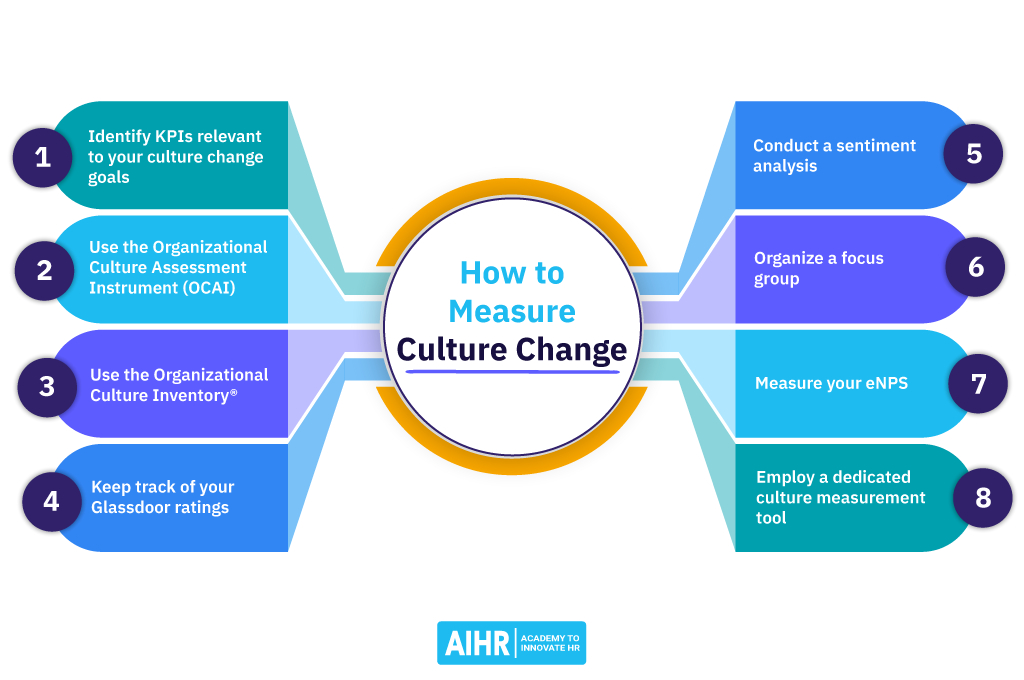
-
Source : Academy To Innovate HR
-
Other departments, such as HR and external consultants help, can also be considered. Cultural transformation is a journey and a continuous process.
3.Agile Adoption
-
Agile techniques encourage iterative development, cooperation, and flexibility in meeting changing needs. CTOs may have challenges implementing agile methods in conventional hierarchical systems and reluctance to change existing procedures. Solutions include:
-
Educating teams in agile concepts.
-
Forming cross-functional teams.
-
Delegating decision-making to lower levels.
-
Cultivating a culture of continuous improvement.
-
This can be a solution for the CTOs in driving innovation in established companies.
-
Some of the popular tools for implementing Agile are Jira, Clickup, and Asana.
4.Strategic Talent Management
-
Strategic personnel management entails attracting, maintaining, and developing competent individuals aligned with organizational objectives. CTOs may need help discovering and hiring individuals with the specialized capabilities required for modernization projects. Potential solutions include:
-
Talent mapping.
-
Succession planning.
-
Targeted recruiting tactics.
-
Employee development programs.
-
Cultivating a learning and growth culture.
Strategies to manage talent
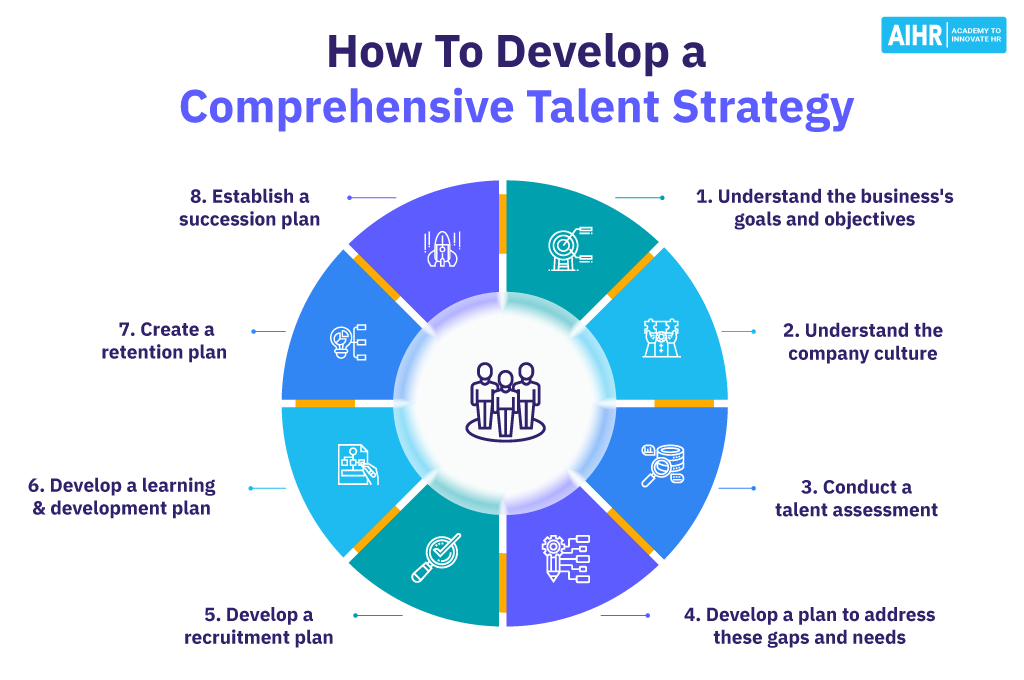
-
Source :- Academy To Innovate HR
-
Just like sales funnels, hiring funnels can be maintained. The dropoff at each step of the funnel can be improved.
5.Continuous Innovation and Adaptation
-
Organizations must constantly innovate and adapt to be competitive in a fast-changing market. CTOs may face resistance to experimentation and risk-taking and challenges reconciling innovation with operational stability. Solutions include:
-
Establishing specialized innovation teams
-
Rewarding innovation
-
Introducing feedback systems
-
Cultivating a culture that values creativity and adaptability
6.Strategic Investment Planning
- Effective investment planning entails carefully allocating resources to support organizational goals and efforts. CTOs may face funding constraints, conflicting agendas, and ambiguity regarding the ROI of technological efforts. Cost-benefit analysis, project prioritization based on strategic alignment and potential effect, alternative financing sources, and developing performance metrics to quantify ROI are all possible solutions. These can help CTOs drive innovation in established companies.
7.Customer-Centric Innovation
- Customer-centric innovation focuses on understanding customers' wants and preferences to create valuable products and services. CTOs may have difficulties acquiring and analyzing client input and aligning internal operations with customer expectations. Potential solutions are implementing consumer feedback systems, conducting market research, encouraging cross-functional collaboration, and prioritizing efforts that address customer pain areas. For customer-centric innovation, CTOs can use various methods, such as customer journey mapping, design thinking workshops, user personas, customer interviews and surveys, prototype testing, data analytics, etc. This can be a solution for the CTOs in driving innovation in established companies.
8.Regulatory Compliance by Design
-
Organizations must ensure that goods and services comply with applicable rules and regulations. CTOs may need help to navigate complicated regulatory environments and incorporate compliance standards into product development processes. Solutions include including legal experts early in the design process, performing frequent compliance audits, establishing strong data protection safeguards, and remaining up to date on legislative changes. These can help CTOs drive innovation in established companies.
-
Many SAAS platforms are available that can monitor compliance risks in real time. Preventive and corrective measures should be defined and implemented.
9.Scalable and Flexible Architectures
- Scalable and flexible infrastructures allow organizations to respond to changing business demands and support expansion. CTOs may need help developing and executing architectures that scale effortlessly while integrating with existing systems. Adopting modular design concepts, utilizing cloud-based technologies, integrating microservices architecture, and prioritizing interoperability and extensibility are all viable solutions. This can be a solution for the CTOs in driving innovation in established companies.
10.Effective Change Management
- Effective change management techniques, including as communication plans, training programmes, and organisational support systems, help to ensure that new technology and processes are adopted and integrated seamlessly. CTOs may reduce disruption and assure project success by proactively addressing opposition to change, providing enough support, and cultivating an innovative culture. in this way Digiqt can help CTOs in overcoming project delivery challenges.
Conclusion
-
In conclusion, promoting innovation in established businesses involves a comprehensive approach that includes strategic vision, organizational alignment, and a commitment to continual improvement. Chief Technology Officers (CTOs) are essential in driving innovation efforts, overcoming diverse difficulties, and unlocking new prospects for development and competition.
-
Partnering with specialized organizations, such as Digiqt Technolabs, may help overcome these issues by providing knowledge in software development, AI solutions, and regulatory compliance. CTOs may expedite innovation projects, improve development processes, and provide value for customers and stakeholders using external resources and best practices.
Contact Us
About Us
We are a trusted, quality driven and value-driven digital product development company delivering services in BFSI sector.
Digiqt Technolabs is a passion turned into a company. We are a trusted product development company that specializes in turning your ideas into digital solutions utilizing our years of experience in industry-leading technologies.
We deliver high-tech innovations and great solutions for our clients in the most efficient manner regardless of the project complexity.
We are trusted, quality-driven and value-driven product development company.

Our key clients
Companies we are associated with
Our Offices

Ahmedabad
706,31FIVE Building,opp.Palladium, Corporate Rd, Makarba, Ahmedabad, Gujarat.
+91 99747 29554

Mumbai
WeWork, Enam Sambhav C-20, G Block,Bandra- Kurla Complex, MUMBAI-400051, Maharashtra.
+91 99747 29554

Stockholm
Bäverbäcksgränd 10 12462 Bandhagen, Stockholm, Sweden.
+46 72789 9039












